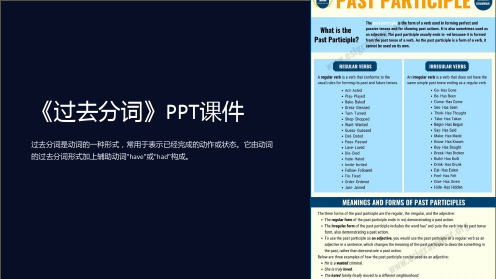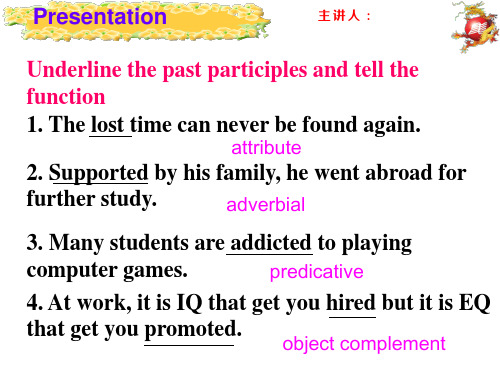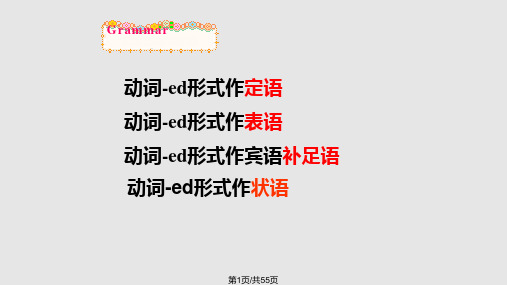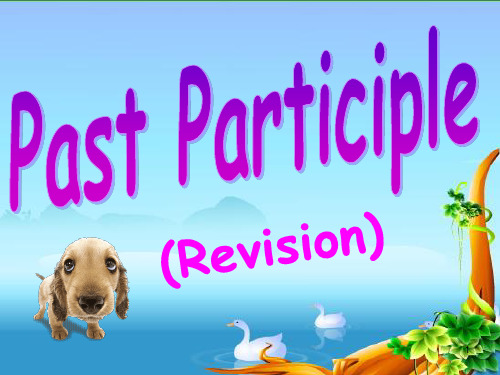过去分词用法优秀课件
合集下载
《过去分词》课件

过去分词的常见错误使用
错误
"I have went to the store."
正确
"I have gone to the store."
错误
"The dog has bited me."
正确
"The dog has bitten me."
《过去分词》PPT课件
过去分词是动词的一种形式,常用于表示已经完成的动作或状态。它由动词 的过去分词形式加上辅助动词"have"或"had"构成。
什么是过去分词
形式
动词的过去分词形式由动词原形加上"-ed"(或其他变形)构成。
功能
过去分词可以用作谓语动词、形容词或独立的名词。
举例
例如:"The broken vase"(打破的花瓶,过去分词作形容词)。
作为名词
例如:"My chosen candidate won the election."
过去分词的时态
过去分词的时态由前面的助动词来决定,如"have"表示现在完成时,"had"表示过去完成时。
现在完成时
例如:"I have finished my homework."
过去完成时
例如:"She had already left when I arrived."
1 完成动作
过去分词可以表示已经完 成的动作,如:"He has eat语 态,如:"The book was written by Mark Twain."
过去分词用法总结(共53张PPT)

further study.
adverbial
3. Many students are addicted to playing
computer games.
predicative
4. At work, it is IQ that get you hired but it is EQ that get you promoted.
What is the language that is spoken in Italy?
What is the language spoken in Italy?
Do you know all the artists invited to the party?
Do you know all the artists who were invited to the party?
1.语态上
现在分词: 表示主动的动作 过去分词: 表示已经被动的动作
I heard someone opening the door .
I heard the door opened .
2.时间上
现在分词: 表示正在进行的动作 过去分词: 表示完成的意思
the falling leaves boiling water the rising sun the fallen leaves boiled water the risen sun
Presentation
主讲人:
Underline the past participles and tell the
function
1. The lost time can never be found again.
attribute
过去分词的各种用法课件精编版

【注意】过去分词所表示的动作一定和宾 语有逻辑上的动宾关系。
“with +宾语+过去分词”结构
“with +宾语+过去分词”结构中,过去分词用作介词 with的 宾语补足语。这一结构通常在句中作时间、方式、条件、原因 等状语。例如:
(1) The murderer was brought in, with his hands tied behind his back. 凶手被带进来了,他的双手被绑在背后。(表方式) (2) With water heated, we can see the steam. 水一被加热,我们 就会看到水蒸气。(表条件) (3) With the matter settled, we all went home. 事情得到解决, 我们都回家了。(表原因) (4) She stood in front of him, with her eyes fixed on his face. 她 站在他面前,眼睛注视着他。 (5) He stood for an instant with his hand still raised. 他仍然举着 手站了一会儿。
(1) Given another hour, I can also work out this problem.
再给我一个小时,我也能解这道题。( given 为过去分词作状语,它的逻辑主语为 主句主语 I ,即 I 被再给一个小时。)
(2) Seen from the top of the hill, the city looks more beautiful to us.
当我们听到英勇事迹后很受感动。
过去分词作定语
1.
We must adapt ourselves to the changed conditions.
“with +宾语+过去分词”结构
“with +宾语+过去分词”结构中,过去分词用作介词 with的 宾语补足语。这一结构通常在句中作时间、方式、条件、原因 等状语。例如:
(1) The murderer was brought in, with his hands tied behind his back. 凶手被带进来了,他的双手被绑在背后。(表方式) (2) With water heated, we can see the steam. 水一被加热,我们 就会看到水蒸气。(表条件) (3) With the matter settled, we all went home. 事情得到解决, 我们都回家了。(表原因) (4) She stood in front of him, with her eyes fixed on his face. 她 站在他面前,眼睛注视着他。 (5) He stood for an instant with his hand still raised. 他仍然举着 手站了一会儿。
(1) Given another hour, I can also work out this problem.
再给我一个小时,我也能解这道题。( given 为过去分词作状语,它的逻辑主语为 主句主语 I ,即 I 被再给一个小时。)
(2) Seen from the top of the hill, the city looks more beautiful to us.
当我们听到英勇事迹后很受感动。
过去分词作定语
1.
We must adapt ourselves to the changed conditions.
《过去分词》课件

例如,cost -> cost, hurt -> hurt
03
过去分词的用法
作为谓语使用
总结词
表示被动或完成
详细描述
过去分词在谓语中常用于表示被动或完成的状态,如“The book was borrowed by me yesterday. (这本书昨天被我借走了。)”中的“borrowed”表示被动,“The dishes have been washed. (盘子 已经洗完了。)”中的“washed”表示完成。
要点一
总结词
表示时间、条件、原因等
要点二
详细描述
过去分词可以作为状语,表示时间、条件、原因等,如 “Having finished the work, she went home. (完成工 作后,她回家了。)”中的“Having finished”表示时间 ,“If seen from the hill, the city looks more beautiful. (如果从山上俯瞰,这座城市看起来更美。)”中 的“seen”表示条件。
填空题练习
总结词
检验学生的应用能力
详细描述
填空题练习主要检验学生是否能够在具体的 语境中正确运用过去分词。这种题型可以帮 助学生更好地理解过去分词的用法,并提高 他们的语言应用能力。
翻译题练习
总结词
提升学生的语言转换能力
详细描述
翻译题练习主要通过英汉互译的方式,让学 生在实际操作中加深对过去分词的理解和运 用。这种题型可以帮助学生提高语言转换能
过去分词
强调动作的完成和结果,常与时间状 语连用,表示某个动作在某个时间点 之前已经完成。
现在分词
强调动作的进行和过程,常与时间状 语连用,表示某个动作正在进行中。
03
过去分词的用法
作为谓语使用
总结词
表示被动或完成
详细描述
过去分词在谓语中常用于表示被动或完成的状态,如“The book was borrowed by me yesterday. (这本书昨天被我借走了。)”中的“borrowed”表示被动,“The dishes have been washed. (盘子 已经洗完了。)”中的“washed”表示完成。
要点一
总结词
表示时间、条件、原因等
要点二
详细描述
过去分词可以作为状语,表示时间、条件、原因等,如 “Having finished the work, she went home. (完成工 作后,她回家了。)”中的“Having finished”表示时间 ,“If seen from the hill, the city looks more beautiful. (如果从山上俯瞰,这座城市看起来更美。)”中 的“seen”表示条件。
填空题练习
总结词
检验学生的应用能力
详细描述
填空题练习主要检验学生是否能够在具体的 语境中正确运用过去分词。这种题型可以帮 助学生更好地理解过去分词的用法,并提高 他们的语言应用能力。
翻译题练习
总结词
提升学生的语言转换能力
详细描述
翻译题练习主要通过英汉互译的方式,让学 生在实际操作中加深对过去分词的理解和运 用。这种题型可以帮助学生提高语言转换能
过去分词
强调动作的完成和结果,常与时间状 语连用,表示某个动作在某个时间点 之前已经完成。
现在分词
强调动作的进行和过程,常与时间状 语连用,表示某个动作正在进行中。
过去分词变化规则-PPT课件

2.词尾为-ow,-aw时,过去式将其变为-ew,过去分词在 其原形后加n。
blow—blew—blown draw—drew—drawn grow— grew—grown know—knew—known throw—threw—thrown (show除外)
3.词尾为“i+辅(1个)+e”,过去式将i变为o,过去 分词多在原形后加n,若那个辅音字母为d或t,须双写d或 t后加n。(give,hide除外)
过去分词的用法
表示动作的完成 或者被动
一.AAA型(动词原形、过去式、过去分词同形)
cost(花费)cost--cost cut(割)--cut--cut hit(打)--hit-- hit hurt 伤害)--hurt-- hurt let(让)--let --let put(放)--put --put read (读)--read-- read
11.改变元、辅音字母。
leave—left—left stand—stood—stood have(has)— had—had understand—understood—understood
五.ABC型(动词原形、过去式与过去分词三者不同形)
1.i—a—u变化。
begin—began—begun drink—drank—drunk sing— sang—sung ring—rang—rung swim—swam—swum sink— sank—sunk
2.词尾有-ild,-end时,只需把d变为t。
build—built—built lend—lent— lent send—sent—sent spend—spent— spent
3.过去式、过去分词都含有 -aught。
过去分词课件PPT课件

Grammar
动词-ed形式作定语 动词-ed形式作表语 动词-ed形式作宾语补足语 动词-ed形式作状语
第1页/共55页
一、动词-ed形式作定语
过去分词作定语往往与被修饰的词靠得很 紧, 渐渐地成为一个复合词。这种分词叫分词
形容词 (the Participle Adjective), 实际上相当
动词的-ed形式可以在“主语+谓语+宾 语+宾语补足语”句型中充当宾语补足语。 在这一结构中, 动词-ed形式和它前面的宾 语构成逻辑上的被动关系。如果这种句子 改为被动语态,原来的宾语补足语变成了主 语补足语。
第17页/共55页
People found the girl beaten black and blue. 人们发现这个女孩被打得青一块紫一块。 (宾语补足语) The girl was found beaten black and blue. (主语补足语)
He grew much tired of the work.
他十分厌倦这工作。
He seemed quite delighted at the idea.
听了这想法他似乎很高兴。 第12页/共55页
高考题
1) Cleaning women in big cities usually get
____ by the hour. (NMET98)
I have never heard him spoken ill of others.
我从未听过有人说他的坏话。
She felt a great weight taken off her mind.
她觉得心里轻松了些。
They considered the matter settled.
动词-ed形式作定语 动词-ed形式作表语 动词-ed形式作宾语补足语 动词-ed形式作状语
第1页/共55页
一、动词-ed形式作定语
过去分词作定语往往与被修饰的词靠得很 紧, 渐渐地成为一个复合词。这种分词叫分词
形容词 (the Participle Adjective), 实际上相当
动词的-ed形式可以在“主语+谓语+宾 语+宾语补足语”句型中充当宾语补足语。 在这一结构中, 动词-ed形式和它前面的宾 语构成逻辑上的被动关系。如果这种句子 改为被动语态,原来的宾语补足语变成了主 语补足语。
第17页/共55页
People found the girl beaten black and blue. 人们发现这个女孩被打得青一块紫一块。 (宾语补足语) The girl was found beaten black and blue. (主语补足语)
He grew much tired of the work.
他十分厌倦这工作。
He seemed quite delighted at the idea.
听了这想法他似乎很高兴。 第12页/共55页
高考题
1) Cleaning women in big cities usually get
____ by the hour. (NMET98)
I have never heard him spoken ill of others.
我从未听过有人说他的坏话。
She felt a great weight taken off her mind.
她觉得心里轻松了些。
They considered the matter settled.
过去分词的用法复习课件

写的,并且这个动作已经完成。
过去分词与现在完成时态的区
04
别
现在完成时态与过去分词在时间上的区别
01
现在完成时态的动作或状态发生 在过去,但与现在仍有联系,而 过去分词则表示动作或状态已经 完全结束,与现在没有联系。
02
现在完成时态通常与表示现在的 助动词have或has连用,而过去 分词则与表示过去的助动词was、 were或had连用。
THANKS
感谢您的观看
用于被动语态的过去分词
总结词
被动语态中的过去分词表示动作已经完成, 并且强调动作对主语的影响。
详细描述
在被动语态中,过去分词通常放在句首,作 为谓语的一部分,表示主语是动作的承受者。 例如:“The book was written by him.” 这句话中的“written by him”就是一个被 动语态中的过去分词,强调“书”是“他”
不正确用过去分词的时态和语态
总结词
过去分词在不同时态和语态中的使用不准确。
详细描述
过去分词在不同的时态和语态中有不同的形式,如“written”和“having written”, 容易混淆。
混淆过去分词与其相关词类的用法
总结词
将过去分词与其他相关词类混淆使用。
VS
详细描述
过去分词与动词不定式、现在分词等其他 相关词类在用法上有区别,容易混淆。例 如,“to write”和“written”。
独立主格结构中的过去分词
总结词
独立主格结构中的过去分词表示动作已经完成,并且与主句之间存在逻辑上的主谓关系。
详细描述
在独立主格结构中,过去分词通常放在句首,作为伴随状语,表示一个动作在主句动作之前已经完成。例如: “The book written by him is very popular.”这句话中的“written by him”就是一个独立主格结构,表示“ 他写的书”这个动作已经完成。
过去分词与现在完成时态的区
04
别
现在完成时态与过去分词在时间上的区别
01
现在完成时态的动作或状态发生 在过去,但与现在仍有联系,而 过去分词则表示动作或状态已经 完全结束,与现在没有联系。
02
现在完成时态通常与表示现在的 助动词have或has连用,而过去 分词则与表示过去的助动词was、 were或had连用。
THANKS
感谢您的观看
用于被动语态的过去分词
总结词
被动语态中的过去分词表示动作已经完成, 并且强调动作对主语的影响。
详细描述
在被动语态中,过去分词通常放在句首,作 为谓语的一部分,表示主语是动作的承受者。 例如:“The book was written by him.” 这句话中的“written by him”就是一个被 动语态中的过去分词,强调“书”是“他”
不正确用过去分词的时态和语态
总结词
过去分词在不同时态和语态中的使用不准确。
详细描述
过去分词在不同的时态和语态中有不同的形式,如“written”和“having written”, 容易混淆。
混淆过去分词与其相关词类的用法
总结词
将过去分词与其他相关词类混淆使用。
VS
详细描述
过去分词与动词不定式、现在分词等其他 相关词类在用法上有区别,容易混淆。例 如,“to write”和“written”。
独立主格结构中的过去分词
总结词
独立主格结构中的过去分词表示动作已经完成,并且与主句之间存在逻辑上的主谓关系。
详细描述
在独立主格结构中,过去分词通常放在句首,作为伴随状语,表示一个动作在主句动作之前已经完成。例如: “The book written by him is very popular.”这句话中的“written by him”就是一个独立主格结构,表示“ 他写的书”这个动作已经完成。
高中英语过去分词的用法课件(共53张PPT)

– Can those ____ at the
back of the classroom
hear me?
A. seat
B. sit
C. seated D. sat
35、___ in the queue for half an hour, the man suddenly realized he had left the money in the car. A. Waiting B. To wait C. Having Waited D. To have waited
非谓语动词的用法讲解:
过去分词的用法
过去分词作定语
作定语用的过去分词相当于形容词,表被动或表完成
1. 过去分词用作定语,如果是单个词语,常置于其所修 饰的名词之前。
The injured workers are now being taken care of in the hospital.
2.过去分词用作定语,如果是短语,一般置于其所修饰的 名词之后,其意义相当于一个定语从句。
The two theories were interesting. The news were disappointing. The result of the exam is delighting. What he does is satisfying.
• They were __s_u_rp__ri_s_e_d__ at the news.(惊奇于)
因为写得匆忙,这篇文章不是很好。
值得注意的是,有些过去分词作状语时不表 被动而表主动。这样的过去分词及短语常见 的有:
lost ( 迷 路 ) ; seated ( 坐 ) ; hidden ( 躲 ) ; stationed ( 驻 扎 ) ; lost / absorbed in ( 沉 溺 于 ) ; born (出身于); dressed in (穿着); tired of (厌烦)。
过去分词用法-PPT课件

•9
定语
3. 被修饰词是由 不定代词 Every/ some/ any/no + thing/ body 所构成的,V-ed后置。 例:有人受伤吗? Is anybody injured?
•10
定语
4. V-ed 短语做(后置)定语,相当于定语从句 He is reading a novel written by Lu Xun. He is reading a novel (which was) written by Lu Xun.
•23
宾语补足语
• 3. 表“希望”、“要求”、“命令” 等 • 如 like, want, wish, order……
例:我可不想我的女儿天黑以后被带出去 I don’t want my daughter to be taken out after dark.
* Want to do sth. Want sb./ sth. done (被动)
•24
宾语补足语
• (to) V./ V-ing/ V-ed 作宾补的区别 I saw him take away the book just now. 主动(结果) I saw him taking away the book on the desk正. 在(过程) I saw the book taken away by a child. 被动
* See sb./ sth. done
•21
宾语补足语
2. 表“使让” 使役动词(let, make, get, keep, leave, have) + V-ed, 表使让。
It was so cold that the driver couldn’t get the car started.
定语
3. 被修饰词是由 不定代词 Every/ some/ any/no + thing/ body 所构成的,V-ed后置。 例:有人受伤吗? Is anybody injured?
•10
定语
4. V-ed 短语做(后置)定语,相当于定语从句 He is reading a novel written by Lu Xun. He is reading a novel (which was) written by Lu Xun.
•23
宾语补足语
• 3. 表“希望”、“要求”、“命令” 等 • 如 like, want, wish, order……
例:我可不想我的女儿天黑以后被带出去 I don’t want my daughter to be taken out after dark.
* Want to do sth. Want sb./ sth. done (被动)
•24
宾语补足语
• (to) V./ V-ing/ V-ed 作宾补的区别 I saw him take away the book just now. 主动(结果) I saw him taking away the book on the desk正. 在(过程) I saw the book taken away by a child. 被动
* See sb./ sth. done
•21
宾语补足语
2. 表“使让” 使役动词(let, make, get, keep, leave, have) + V-ed, 表使让。
It was so cold that the driver couldn’t get the car started.
过去分词的用法全面(共46张PPT)

eg: There was nobody invited here. I want to find somebody interested in the
case.
2. v-ed作定语与定语从句的互换: (1) 若是vt.的过去分词作定语表示已经完成的 动作,且含有被动意义,可改成v.用被动形 式的定语从句。
eg: surprisng; moved/ moving...
二、作定语 (attribute)
1. 前置定语:单个的v-ed作定语,一般放在 被修饰的n.之前; 后置定语:v-ed短语作定语时,常被放在被 修饰的n.之后,相当于一个定语从句。 eg: an invited guest 一位受到邀请的客人
过去分词所充当的成分:
一、作表语 (predicative)
1. 过去分词作表语,表示主语的心理感觉或 所处的状态,其用法相当于adj.,放在系动 词后面。 eg: The door remained locked till 7 o’clock.
eg: I am pleased with the result of the
eg: The injured bird lay on the ground.
eg: a letter written in blue ink
eg: The boy named Tom is my brother.
注意:
如果被修饰的词是复合不定代词或指示代词 those等时,即使是一个单一的分词作定语也 要放在被修饰的词之后。
eg: The letter posted today will reach you in a week. =
The letter which was posted today will...
case.
2. v-ed作定语与定语从句的互换: (1) 若是vt.的过去分词作定语表示已经完成的 动作,且含有被动意义,可改成v.用被动形 式的定语从句。
eg: surprisng; moved/ moving...
二、作定语 (attribute)
1. 前置定语:单个的v-ed作定语,一般放在 被修饰的n.之前; 后置定语:v-ed短语作定语时,常被放在被 修饰的n.之后,相当于一个定语从句。 eg: an invited guest 一位受到邀请的客人
过去分词所充当的成分:
一、作表语 (predicative)
1. 过去分词作表语,表示主语的心理感觉或 所处的状态,其用法相当于adj.,放在系动 词后面。 eg: The door remained locked till 7 o’clock.
eg: I am pleased with the result of the
eg: The injured bird lay on the ground.
eg: a letter written in blue ink
eg: The boy named Tom is my brother.
注意:
如果被修饰的词是复合不定代词或指示代词 those等时,即使是一个单一的分词作定语也 要放在被修饰的词之后。
eg: The letter posted today will reach you in a week. =
The letter which was posted today will...
过去分词用法详解ppt课件

A. recorded
B. record
D. having recorded
4.Linda worked for the Minnesota Manufacturing and Mining
company, _B__as 3M.(04’ZJ)
A. knowing B. known C. being known D. to be known
6
﹡ ﹡ The differences (used as Attribute)
5. to do 表示一个将来的动作 to be done 表示一个将来的被动动作 doing 表示一个正在进行的主动动作 being done 表示一个正在进行的被动动作 e.g. I have much work to do. The building to be finished at the end of this year will be our lab
2.介词with+宾语+过去分词
The thief was brought in with his hands tied behind his back. With all the work finished, he went back.
15
Exercises:
1.You should understand the traffic rule by now. You’ve had it
5.----Shall we go swimming ?
----OK. I’ll just go and get __A___.
A. changed B. to change C. to be changed D. changing
13
Step Ⅲ used as Object Complement 1.及物动词的过去分词作宾补表示一个完成且被动的动 作; 不及物动词的过去分词作宾补只表示动作的完成和 状态。
- 1、下载文档前请自行甄别文档内容的完整性,平台不提供额外的编辑、内容补充、找答案等附加服务。
- 2、"仅部分预览"的文档,不可在线预览部分如存在完整性等问题,可反馈申请退款(可完整预览的文档不适用该条件!)。
- 3、如文档侵犯您的权益,请联系客服反馈,我们会尽快为您处理(人工客服工作时间:9:00-18:30)。
many Chinese people
定语
5. V-ed作定语时の三种时态
• The building built last year is very beautiful. (已发生) • The building big built will be completed next month. (正在发生) • The building to be built will be a hospital. (将来时)
过去分词用法优秀课件
1、谓语*
2、表语
目
3、定语
录
4、状语
5、宾语补足语
谓 语*
• “Have + 过去分词” → 完成时/非谓语动词的完成时 我已经看过这个电影了 I have seen this film already. 你看见我的包了么? Have you seen my bag?
• “be + 过去分词” → 被动/非谓语动词的被动 孩子们被照顾得很好 The children were well looked after
V-ed 短语做非限制性定语,相当于非限制性定语从句 The books, written by Lu Xun, are popular with many Chinese
people. The books, which was written by Lu Xun, are popular with
伴随状况。 例:他们安静地坐在那里,眼睛盯着湖面。 They sat there silently, with their eyes fixed on the lake. The thief was brought in, with his hands tied behind his back.
• 作为一个艺术家,她很有天赋。 As an artist, she is quite gifted.
定语
• 不及物 V-ed 作定语,表 • 及物V-ed 作定语,表被
动作已完成。 被动
动或已完成的被动。
• 落叶 fallen leaves
• 退休的老师 A retired teacher
• 升起的太阳 risen sun
状语
1. V-ed作状语,表被动或完成的动作。 Written in a hurry, the article was not so good!
• 不及物V-ed不表被动,只表完成。 fallen leaves
• 有些V-ed来源于系表结构,作状语不表被动而表主动: Lost, seat, hidden, stationed, born, Lost/absorbed in, dressed in, tired of… eg: Lost in deep thought, he didn’t hear the sound.
Born in this beautiful town, he hates to leave it.
状语
2. V-ed 作状语,其逻辑主语 = 主句主语时, 应注意人称一致。
• _B_e_l_ie_v_in_g_ the earth to be flat, many feared that Columbus would fall off the edge.
表语
2. 表语 vs. 被动
• Be+V-ed 表状态 V-ed相当于adj. • The shop is closed now. • The window is broken. • The town is surrounded by hills.
• V-ed 表动作(被动语态) • It was broken by Tim • It usually closed at 8 pm. • It will be completed next spring.
• 一位受尊敬的客人 an honored guest
• 一个分裂的国家 a divided country.
定语
2. V-ed 作定语,一般在被修饰词之前。 The broken clock should be repaired as soon as possible.
• 但也有个别V-ed 习惯后置。 There is little time left. I want to change the material used.
表语
3. 当人做主语时,用V-ed做表语,表主语的思想感情。
• 当我们听到这个故事的时候, 我们被深深的感动了。 When we heard of the story, we were deeply moved.
表语
4. 某些V-ed并非m ashamed of myself for it.
定语
3. 被修饰词是由 不定代词 Every/ some/ any/no + thing/ body 所构成的,V-ed后置。
例:有人受伤吗? Is anybody injured?
定语
4. V-ed 短语做(后置)定语,相当于定语从句 He is reading a novel written by Lu Xun. He is reading a novel (which was) written by Lu Xun.
表语
实意动词
• 主语+谓语+宾语
(半)系动词
• 主语+系动词+表语
表语
1. V-ed 放在系动词(be, get, feel, seem, look, become)之后做
表语,表示性质,特征,状态。
主要表示动作的完成和状态,相当于adj.
• 我的心碎了。 My heart is broken. • 玻璃被Jack打碎了 The glass was broken by Jack. • 门仍然锁着。 The door remained locked.
• __S_e_e_n___ from the hills, the city looks beautiful.
状语
2. V-ed 作状语,前面再加逻辑主语,主句的主语不再是分局 句逻辑主语,这种带主语的过去分词叫做__独__立__主__格__结__构__
• The signal given, the bus started. • __独__立__主__格__结__构___有时也用 “with/without + n.+分词” 表示
定语
5. V-ed作定语时の三种时态
• The building built last year is very beautiful. (已发生) • The building big built will be completed next month. (正在发生) • The building to be built will be a hospital. (将来时)
过去分词用法优秀课件
1、谓语*
2、表语
目
3、定语
录
4、状语
5、宾语补足语
谓 语*
• “Have + 过去分词” → 完成时/非谓语动词的完成时 我已经看过这个电影了 I have seen this film already. 你看见我的包了么? Have you seen my bag?
• “be + 过去分词” → 被动/非谓语动词的被动 孩子们被照顾得很好 The children were well looked after
V-ed 短语做非限制性定语,相当于非限制性定语从句 The books, written by Lu Xun, are popular with many Chinese
people. The books, which was written by Lu Xun, are popular with
伴随状况。 例:他们安静地坐在那里,眼睛盯着湖面。 They sat there silently, with their eyes fixed on the lake. The thief was brought in, with his hands tied behind his back.
• 作为一个艺术家,她很有天赋。 As an artist, she is quite gifted.
定语
• 不及物 V-ed 作定语,表 • 及物V-ed 作定语,表被
动作已完成。 被动
动或已完成的被动。
• 落叶 fallen leaves
• 退休的老师 A retired teacher
• 升起的太阳 risen sun
状语
1. V-ed作状语,表被动或完成的动作。 Written in a hurry, the article was not so good!
• 不及物V-ed不表被动,只表完成。 fallen leaves
• 有些V-ed来源于系表结构,作状语不表被动而表主动: Lost, seat, hidden, stationed, born, Lost/absorbed in, dressed in, tired of… eg: Lost in deep thought, he didn’t hear the sound.
Born in this beautiful town, he hates to leave it.
状语
2. V-ed 作状语,其逻辑主语 = 主句主语时, 应注意人称一致。
• _B_e_l_ie_v_in_g_ the earth to be flat, many feared that Columbus would fall off the edge.
表语
2. 表语 vs. 被动
• Be+V-ed 表状态 V-ed相当于adj. • The shop is closed now. • The window is broken. • The town is surrounded by hills.
• V-ed 表动作(被动语态) • It was broken by Tim • It usually closed at 8 pm. • It will be completed next spring.
• 一位受尊敬的客人 an honored guest
• 一个分裂的国家 a divided country.
定语
2. V-ed 作定语,一般在被修饰词之前。 The broken clock should be repaired as soon as possible.
• 但也有个别V-ed 习惯后置。 There is little time left. I want to change the material used.
表语
3. 当人做主语时,用V-ed做表语,表主语的思想感情。
• 当我们听到这个故事的时候, 我们被深深的感动了。 When we heard of the story, we were deeply moved.
表语
4. 某些V-ed并非m ashamed of myself for it.
定语
3. 被修饰词是由 不定代词 Every/ some/ any/no + thing/ body 所构成的,V-ed后置。
例:有人受伤吗? Is anybody injured?
定语
4. V-ed 短语做(后置)定语,相当于定语从句 He is reading a novel written by Lu Xun. He is reading a novel (which was) written by Lu Xun.
表语
实意动词
• 主语+谓语+宾语
(半)系动词
• 主语+系动词+表语
表语
1. V-ed 放在系动词(be, get, feel, seem, look, become)之后做
表语,表示性质,特征,状态。
主要表示动作的完成和状态,相当于adj.
• 我的心碎了。 My heart is broken. • 玻璃被Jack打碎了 The glass was broken by Jack. • 门仍然锁着。 The door remained locked.
• __S_e_e_n___ from the hills, the city looks beautiful.
状语
2. V-ed 作状语,前面再加逻辑主语,主句的主语不再是分局 句逻辑主语,这种带主语的过去分词叫做__独__立__主__格__结__构__
• The signal given, the bus started. • __独__立__主__格__结__构___有时也用 “with/without + n.+分词” 表示
